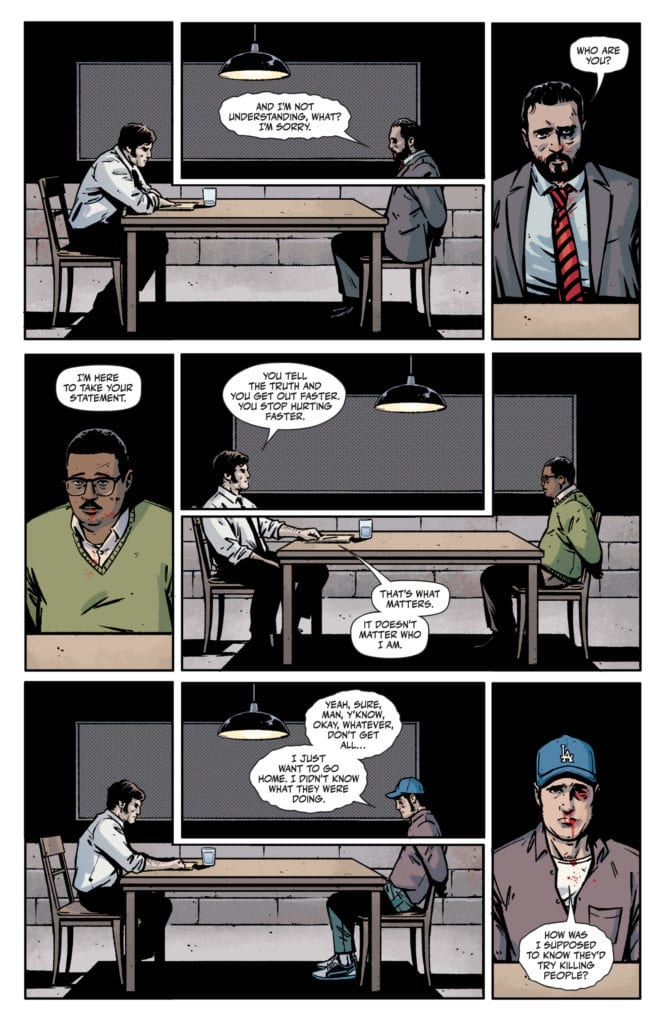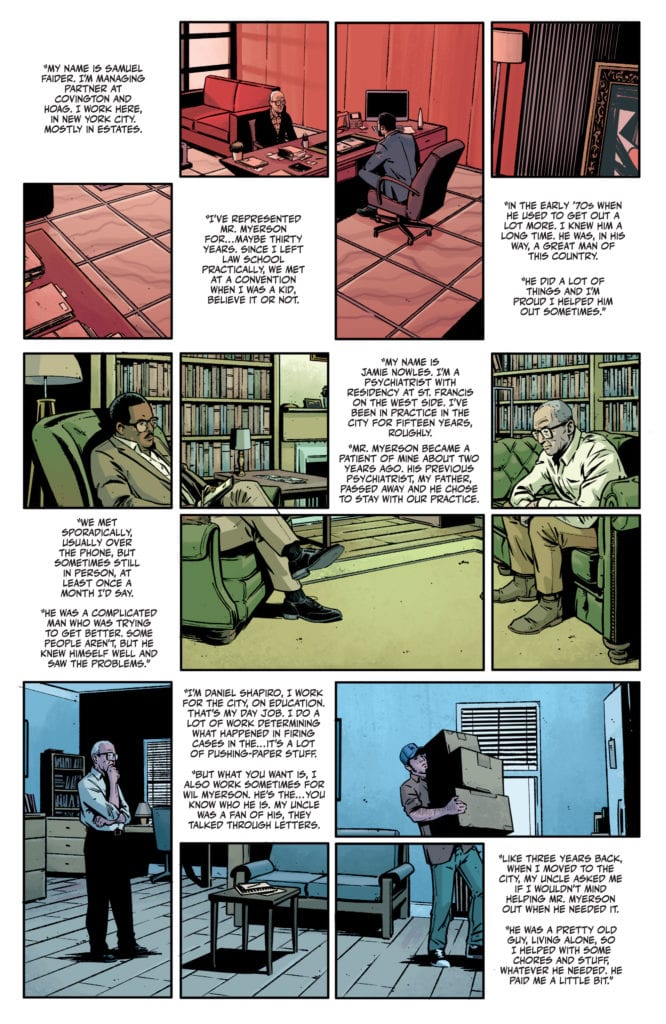The story of DC Comics’ series Rorschach is complex and confusing. But writer Tom King, artist Jorge Fornes, colorist Dave Stewart, and letterer Clayton Cowles don’t let us think for a second that that’s because they are being unclear. No, Rorschach #8 is incredibly clear. It’s concise and meticulously ordered. Yet somehow, this creative team is able to communicate chaos. It’s through order that they show us what’s missing and what doesn’t make sense. They lay everything out carefully, that way we can see all the holes. This creative team continues to use their incredible powers to blow our minds.
Writing
King has never been so verbose. His pages are full of text in this issue. King is usually known for his quiet comics. Often, the pauses in his scripts speak louder than the words do. This issue is actually no exception. Our main character, the detective figuring out the story behind Wil Myerson, is interrogating three people. Each witness has a lot to say. Their accounts spare no details. For every brief question, there’s a long answer. But everything about their testimonies feels harmless. We begin to wonder if the detective has gone down the wrong rabbit trail, or if he’s just being played. King masterfully skirts past holes in each story, then comes back to make us question what we think we know. It’s like he dumps all the puzzle pieces on us, then shows us that they don’t fit together. They can’t be the right pieces. It’s a brilliant journey that he takes us on in this issue, deepening the mystery with each revelation.

Art
Fornes’ page layouts play a huge role in making us feel like we’re missing part of the picture. He makes use of dead space throughout this issue. Almost every page is more or less a 24 panel grid. Many pages combine some panels, but when you break it down, it’s still 24 panels. Often, pages have panels that are fully dedicated to text. Instead of using caption boxes, we get white panels full of text. And when Fornes combines panels to create one image, with a panel in the middle of that image blanked out for text, we get the sense that we’re missing part of the picture. Because we quite literally are. Fornes makes us feel that it’s the dead space that holds the answers. The issue reads like an evidence board that’s missing what links it all together. It’s fantastic, infuriating, and beautifully done.

Coloring
Stewart’s coloring is deliberately simplified. When one character tells their version of events, those events are shown in a certain hue. When Wil’s lawyer says what he remembers, we see everything through a red haze. Wil’s therapist and handyman recount things in green and blue respectively. Not only does this help us keep track of who’s speaking, but it gives us a sense that the truth is being distorted. We aren’t seeing things as they truly are. When the detective finished his interrogation, he grabs a cup of water from the water cooler. Each plastic cup is colored differently. One is red, one is blue, one is green. As he updates his supervisor on how the interrogation went, we see him drink the water and throw it away. But in each image of the cup, it’s a different color. It’s Stewart’s incredibly simple way of showing how monotonous these things are to the detective. His routine is the same, his conversations with his supervisor don’t change, only the days change. Same thing, different day.
Lettering
Cowles places much of the lettering in this issue in the dead space of each page. The white panels not only get filled with captions, but with the speech bubbles of the characters. Their words go from their mouths in one panel, up into the dead space of another. When Cowles does place captions over an image, he stays true to the style of the rest of the issue. Caption boxes are big and white. They purposefully get in the way of the rest of the picture. And finally, Cowles makes a point of always having quotation marks around the captions. Even when two paragraphs exist in the same caption box, each starts with a quotation mark. Other letterers often omit quotation marks where they can. But Cowles never wants us to forget that we’re being told this story. We won’t forget who the speakers are, Cowles makes sure of that.
DC Comics’ Rorschach #8 is an incomplete picture. It taunts us with the information we don’t have while overloading us with information that doesn’t fit. This creative team impresses upon us what it feels like to look for the truth in a sea of misinformation. They use their ordered, clean storytelling to show us the chaos beneath the surface. Pick up Rorschach #8, out from DC Comics May 11th, at a comic shop near you.

